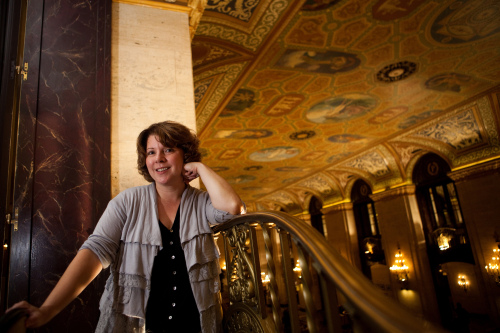On Friday, Feb. 13, 1863, while the Civil War raged on, the Chicago Tribune ran a front-page story on the wedding of Mercy Lavinia Warren Bump to Charles Stratton, better known as General Tom Thumb.
Why did their wedding warrant such attention? Why did their guest list include not only members of the day’s high society, but also President and Mrs. Abraham Lincoln?
Because the couple were tiny people with perfect proportions ― Stratton stood 40 inches high and Bump 32 inches ― and, as such, fascinated the world.
The Tribune article recounts that the crowd of revelers surrounding Grace Church in New York City blocked traffic for four blocks and numbered about “5,000 persons.” The president and his wife were unable to attend; they invited the Thumbs to the White House months later.
But despite this celebrity, not much is known about Mrs. Tom Thumb today. It was this dichotomy that set author Melanie Hauser, whose pen name is Melanie Benjamin, on the path to writing her newest novel, “The Autobiography of Mrs. Tom Thumb.”
“I was looking up famous women in the 19th century on the Internet, and one list had the name Lavinia Warren,” Hauser said. “As soon as I started discovering how very famous she was in her time and yet we don’t know about her, I became intrigued with her story.”
 |
Melanie Hauser, whose pen name is Melanie Benjamin, has written the novel “The Autobiography of Mrs. Tom Thumb.” Her real name was Mercy Lavinia Warren Bump and in the 1800s her height of 32 inches, and her husband’s of 40 inches made them celebrities. (Zbigniew Bzdak/Chicago Tribune/MCT) |
Stratton ― or Thumb ― was already very famous when he met Bump in January 1863, while she was making her debut at the American Museum. Their celebrity was such that they toured the world as the Tom Thumb Company from 1863 to 1878 and traveled with Barnum’s circus in 1881. Hauser’s book describes Bump’s life from her first memories to her husband’s death.
This is Hauser’s second historical fiction novel. Her first was 2010’s best-selling “Alice I Have Been,” about the girl who was Lewis Carroll’s muse for “Alice in Wonderland.”
Being a writer, though, is something Glen Ellyn, Ill.-based Hauser, 48, discovered only about a decade ago.
“I actually started out in theater,” Hauser said. “Then, when I was in my late 30s, a friend of mine said she always thought I would be a writer. … I was always a reader; I always had a book in my hand. Her comment just started a little fire under me to see if I could be a writer.”

It turned out that she could. She began by writing a parenting column for a now-defunct west suburban magazine. She wrote short stories and contemporary novels about a superhero mom, some of which were published by Penguin, before finding her way to historical fiction ― all the while using her theater training.
“I tend to write in the first person,” Hauser said. “I don’t want to limit myself to that always, but it is where I feel most comfortable. I look at it as channeling a voice and inhabiting a person on the page now instead of on the stage. I really try to use everything that I learned while acting; observing life, observing people and creating a back story in my writing.”
Unlike other historical fiction writers who pride themselves on their research, Hauser uses facts only as a skeleton for the story.
“For me the joy of writing is the fiction,” Hauser said. “I say I never let the truth get in the way of a good story. I use the basic known facts to hang the story on, but everything else, what makes a person go from point A to point B, the relationships, the motivations, the fears, I like to fill in with my own imagination.”
The true joy of this book is the multifaceted woman at the heart of the story. Vinnie, as her friends called her, was born with an unidentifiable form of proportionate dwarfism. Her family wished to keep her away from the spotlight, but she craved attention ― and not just for her size.
“Never would I allow my size to define me,” Vinnie says in the novel. “Instead, I would define it. My size may have been the first thing people noticed about me but never, I vowed at that moment, would it be the last.”
This book illuminates the true stories of Vinnie’s life, including signing with P.T. Barnum and meeting and marrying Tom Thumb. It touches on the “child hoax,” in which Barnum requested that the Thumbs pretend to have a child to increase ticket sales and then “killed” the child when the hoax became too much for Vinnie to handle. And it details the tragic life of her beloved sister Minnie.
The novel also makes it obvious that Vinnie could never escape the fact that she was a household name strictly because of her size. Celebrity that comes neither from talent nor intelligence is nothing strange to us: Look no further than today’s “reality” shows.
“The more things change, the more they stay the same,” Hauser said. “We have an intense society of voyeurism. In her time, people were fascinated in seeing a little person live a normal life.
“Certain TV stations today do the same thing, and again you are looking at someone with challenges or who is born differently than you just trying to live a normal life. There is still a great deal of attraction in watching that.”
By Courtney Crowder
(Chicago Tribune)
(MCT Information Services)









